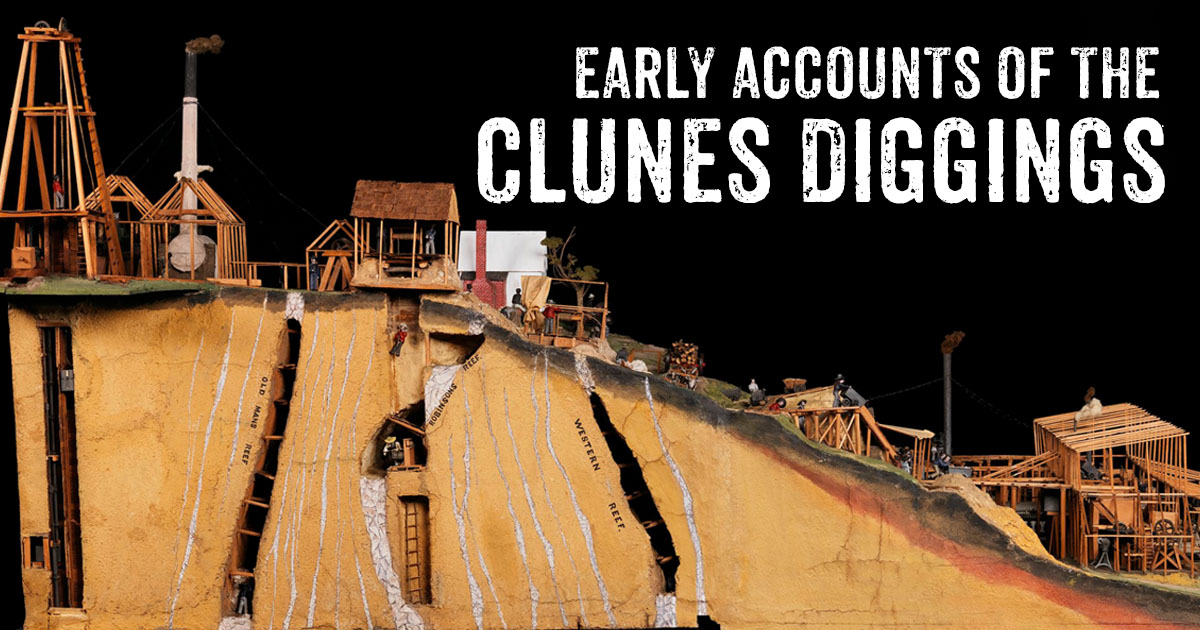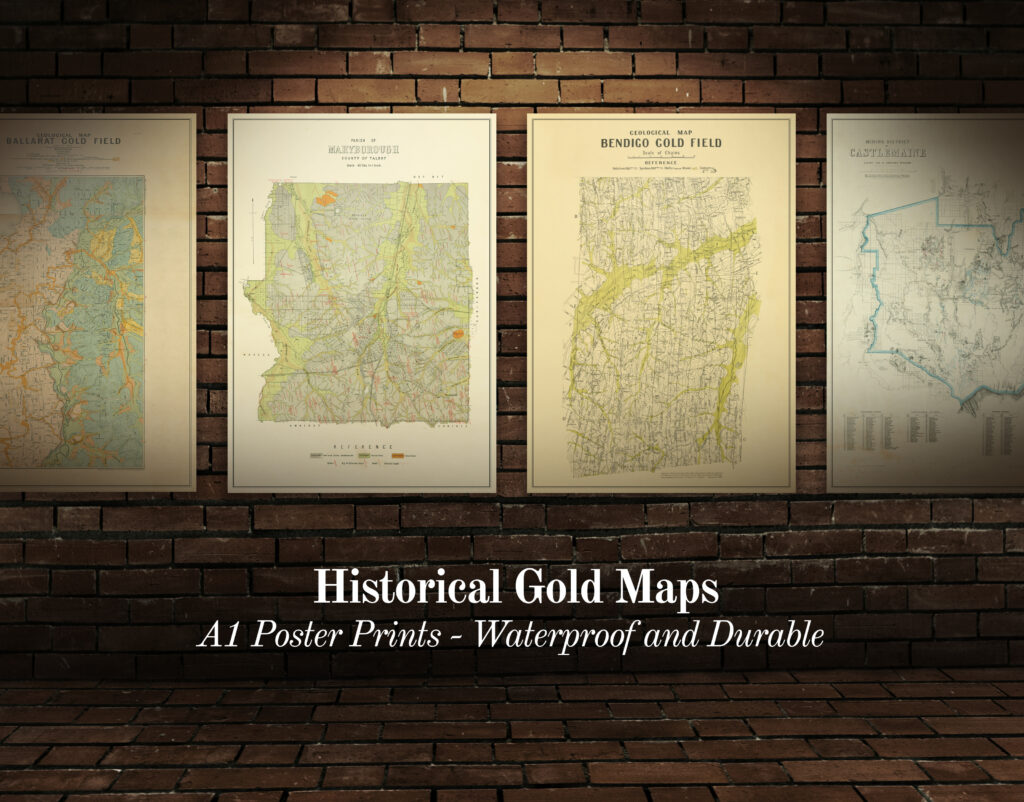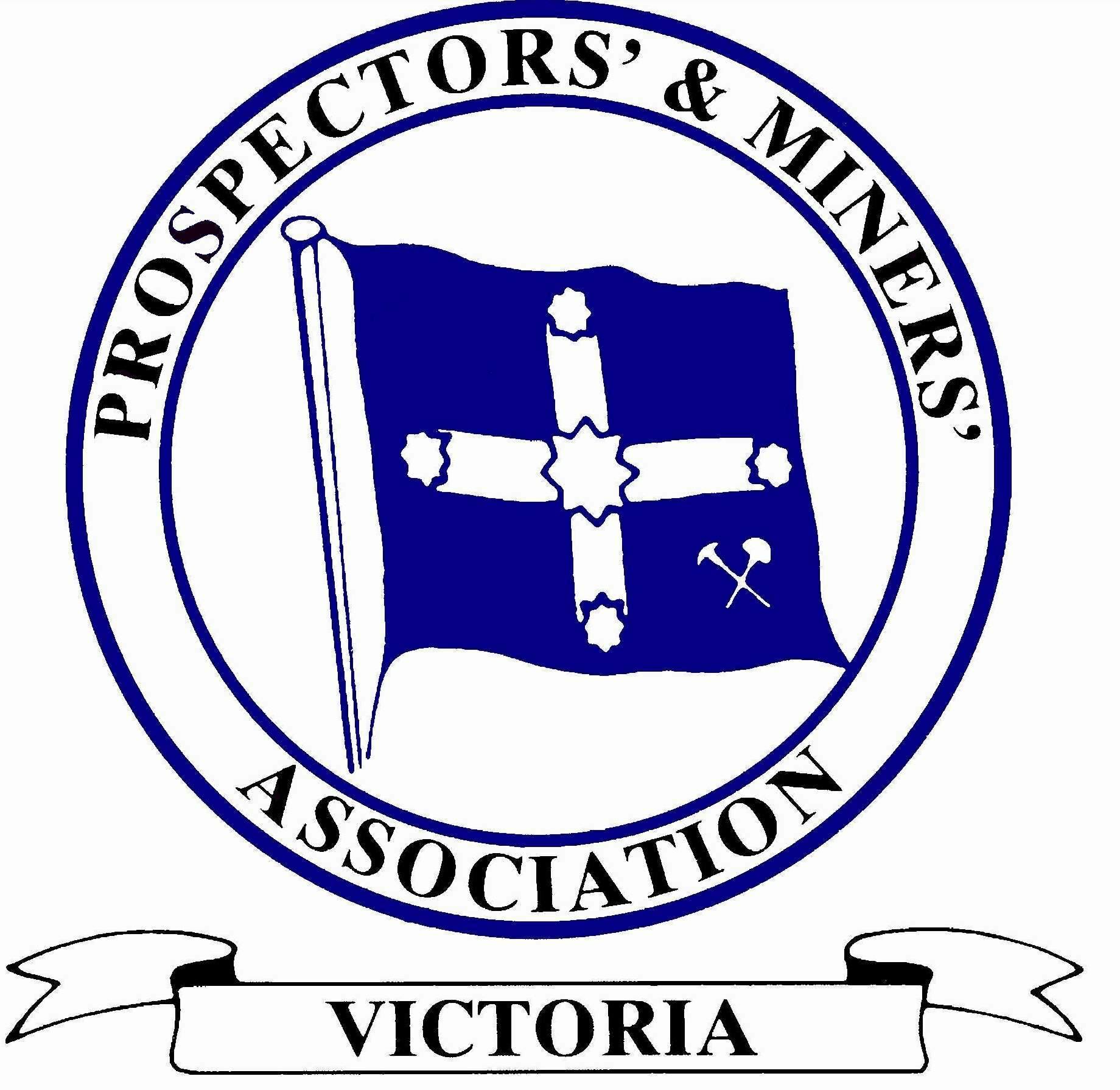
Image background source: Museums Victoria. Model by Carl E. Nordstrom, Port Phillip Quartz Mine and Gold Works at Clunes, as they appeared in Dec 1858.
The Clunes Diggings struck fame as the first marketable gold field in Victoria, beginning in July 1851.
The operations at the Clunes Diggings were more accurately described as 'mining' than 'diggings', as the gold was primarily being obtained from the quarrying of quartz veins rather than the washing of alluvial material.
"...the quartz veins have, where they have been attacked, proved so rich that a large profit might be reasonably anticipated from the use of stamping machines, together with buddles, quick-silver machines, and the other appliances of legitimate mining." - Geelong Advertiser, 8th August 1851
Although the Clunes goldfield was not ideal for the early diggers of Victoria, who soon rushed to the rich alluvial fields of Ballarat, Mount Alexander and Bendigo, the Port Phillip and Colonial Gold Mining Company entered the scene in 1857 and began their lucrative operations, investing heavily in equipment and amassing a great wealth from the quartz reefs at Clunes.

The following accounts were published in newspapers during the first few months of the diggings at Clunes, and give us an interesting insight into the early development of the Clunes Diggings.
25th July 1851
"Eureka! We have gold - gold in abundance. The verification of floating rumours has come, and we feel now in a position to state decisively that which we have long hoped to lay before the public. In area, depth, and richness of yield, the Pyrenean gold field promises to be of first importance. Mr. Davis, of the Avoca, brought to our office yesterday, a beautiful sample of pure gold dust, varying in size from a pins head down to the most minute particles, found on Donald Cameron's Station, at a spot known henceforth as "Clune's Diggings." ... For four miles round, the ground has been dug at intervals, and in every spadeful turned up gold has been found. ... Mr. Esmond and his partner Mr Pew got their cradle into working operation on Thursday last and from the quantities procured by the use of tin dishes, they may anticipate a rich harvest. On this one gold field there are eighteen men at work, and it may be as well to mention that it is within eight miles of the spot where the shepherd found the specimen of gold which caused such a sensation a few years back." - Geelong Advertiser, 25th July 1851
30th July 1851
"At the Clunes diggings, Pyrenees, intending gold-diggers are daily collecting, yet there is not a house for refreshment within fifteen miles, and the nearest store, Burn Bank, which is at present but ill supplied, is more than half that distance." - Geelong Advertiser, 30th July 1851
5th August 1851
"CLUNE DIGGINGS
From our special correspondent.
I reached the Clunes Diggings on Thursday evening, and was most hospitably received by Donald Cameron, Esq, to whom I beg to tender my best thanks for the kindness of his reception, as well as for much useful information respecting the mines, and the proceedings of the gold diggers since their commencement, ... On Friday morning early, I ascended a hill in close propinquity to the house, and at no great distance from the mines. Although the morning was damp and cold, a very busy and to me, a novel and interesting scene presented itself ; the whole colony of diggers appeared to be moving with the industry of a nest of ants, some running or ?lipping down the hill, with dishes on their heads laden with earth, supposed to contain the golden treasure ; others were at work with pickaxes loosening the earth adjoining the veins of quartz, to supply those who were engaged in working either with cradles or tin dishes. Others were boiling water and making preparations for breakfast, and one or two stragglers I observed making their first appearance at the mines with the never failing pedestrian bush-man's equipment (blankets, tin pots, etc) usually, in this colony, denominated "the swag". ... At present I have not heard of a single case of extraordinary luck ; in fact, nothing beyond sufficient to purchase food, which, except meat, is scarce, or not to be had at a less distance than Burn Bank, sixteen miles. There are now at the mines from thirty to thirty-five. ... It is expected that not less than four cradles will be in full operation to-morrow." - The Argus, 5th August 1851
8th August 1851
"The 'Clunes Diggings' are on the Deep Creek, (a tributary to the Loddon,) a few hundred yards from Mr Cameron's station. They have been commonly supposed to be situated in the Pyrenees, but very erroneously, as they are fifteen miles distant from that chain. The existence of gold at this locality has, it seems, been known for the last eighteen months to the neighbouring settlers. Mr Cameron distinctly asserts that he led Dr Bruhn to the spot, and pointed out that gold was imbedded in the quartz vein. Dr Bruhn has, however, the merit of first making the public acquainted with the fact.
"... The gold is found disseminated in several parallel quartz veins or dykes, which pass through this mass of trap, and protrude from it on the steep banks of the valley. There is no tract of auriferous alluvium. The gold is almost entirely derived from the quartz vein itself Hence the works here would be more properly characterized as MINING than DIGGING. ... On the north side of the valley are seen four parallel quartz veins running north and south through a mass of soft decomposed rock. The main vein forms the axis of the spur formerly mentioned. Most of the miners are at work upon this and have quarried it, or laid it open, for a hundred yards up the slope of the bank and on the plain above. In this work the pick and crowbar are indispensable.
"As new comers arrive, they mark out a 'claim,' and proceed to open the back of the vein in the rear of actual operations, farther from the river banks, to which all the auriferous earth and stone must be carried to be washed. ... the soil at the foot of the hill is impregnated with gold washed down from their gradual wasting away. This deposit is exceedingly limited in extent, and not very productive, though the gold here found is purer than that taken from the vein. Yet the works on this alluvium are the only 'diggings' on the spot, properly so called.
"...Mr Esmonds, who first opened the works, and is probably the most intelligent man on the spot, imagines that a cradle in full operation, with a party of four or five miners, might obtain two ounces a day, and that the dishmen, when in full practice, might on the average obtain eight or ten shillings. Others however maintain that this is considerably too high an estimate, both for cradle and dish.
"..On the day I reached the spot, there were about 50 men at work, besides two women, one of whom had established a laundry within an inclosure of gum boughs, doubtless with great profit to her-self and advantage to the mining community. There were individuals of all classes ... Men are arriving every day at the spot.
"...the quartz veins have, where they have been attacked, proved so rich that a large profit might be reasonably anticipated from the use of stamping machines, together with buddles, quick-silver machines, and the other appliances of legitimate mining, provided always that the veins prove both extensive and continuously rich, neither of which has yet been ascertained."
9th August 1851
"...seekers, who continue to gather around the little Clune Hill gold mine like crows around a dead carcase. At the present moment there are no less than sixty or seventy people. The encampment pictures a sight as unique as it is novel, to those who visit a gold mine for the first time. It is situated in a bend of the Deep Creek, and within sight of the residence of D Cameron, Esq, and consists of sod huts, gunyas, tents, tilted carts, and mia mias made of boughs. Through the very admirable precautions on the part of Government in supplying a body of police, there has hitherto prevailed the utmost good order.
"...I observed to-day that some of the men had marked a line around the portion they were digging, as well as two policemen engaged in taking the names of the parties at work; all which look very like the precursor of issuing licenses, in which case I am inclined to think that those who at present can only boast of tin dishes, will have to leave the ground, as unless their profits increase, they will not obtain even sufficient to pay for licenses, and food."
18th August 1851
"There has been a slight addition to the population, which now numbers from 75 to 80 individuals." - Geelong Advertiser, 18th August 1851
18th August 1851
"From those and our own accounts, it appears that the Clunes field is not so rich as was anticipated. The earnings are stated as varying from 5s to 15s per day for each man employed. The field is therefore worth working, but offers very little temptation to labourers at present." - Geelong Advertiser, 18th August 1851
21st August 1851
"The Clunes diggings appear to be barely remunerative - the average earnings being about 85s per week for each man. This is sufficient, however, to show that, when the prices of supplies become reasonable, and the miners have acquired more skill, the pursuit of gold washing, even at Clunes, will deserve to rank with our ordinary resources, as a branch of new industry." - Geelong Advertiser, 21st August 1851
27th August 1851
"The miners seem to be going on steadily there; and there is a probability that these diggings will gradually increase in importance, as they become opened up, and the miners gather experience." - Geelong Advertiser, 27th August 1851
27th August 1851
"27th August - The Gold digger's crisis is fast approaching, Monday next will decide whether many of the persons now occupied here and elsewhere, will remain a legitimised digger, or abandon a pursuit which has rarely if ever proved advantageous. ... In the present case I think that the tax imposed by the Government will, in the majority of instances amount to a prohibition, as I am certain that but few of the diggers can afford to pay 30s, per month ; indeed, I would point out many hard working men who are not earning that amount over their rations and very few indeed, even of the most fortunate, have yet repaid themselves for their outfits. I do not think, then, that many licenses will be paid on Monday, and I fully expect that there will be a great clearing out of camp next week." - The Melbourne Daily News, 30th August 1851
29th August 1851
"The diggers are still going on industriously, but the ranks are gradually thinning and I think that there are now more than eighty on the ground. Faces are very long at the prospect of the heavy license fee, but there are none of those bouncable demonstrations which we hear of at other diggings. The people would be content to pay a moderate tax, but the amount to be levied is far beyond their means." - Geelong Advertiser, 4th September 1851
8th September 1851
"A party of four which left the Buninyong for Clunes diggings have just returned with field intelligence. They state that nothing can be done without quarrying, or blasting, and that it takes a man a whole day to get one bucketfull of earth for the cradle. They further said that the state of the Buninyong gold field would cause a complete desertion from the Clunes diggings, where the gold is -?- in quantity and quality." - The Argus, 8th September 1851
Shop our collection of historical goldfields maps, which show fascinating historical features in superb detail. High quality, durable A1 poster prints in a satin finish. Order yours today!
SEE ALSO
- Historical gold maps of the Clunes goldfield
- Gold prospecting in the Victorian Goldfields
- Gold-bearing creeks and rivers in Victoria
- Diaries and memoirs from the Victorian gold rush



